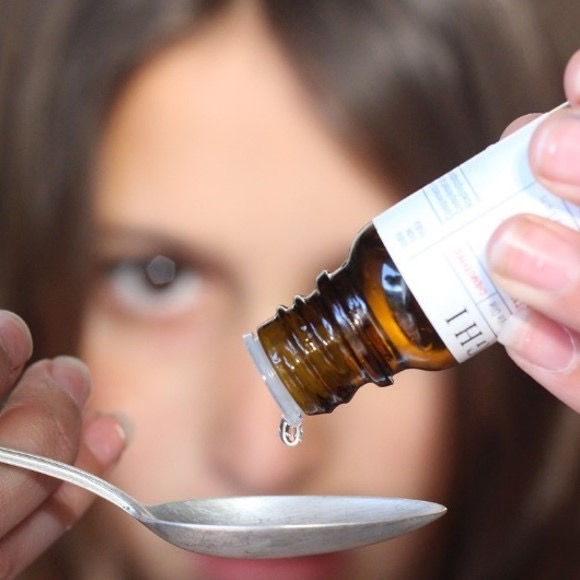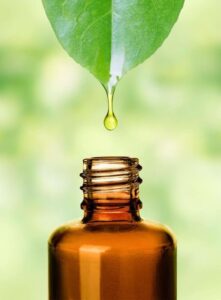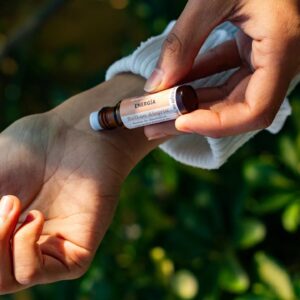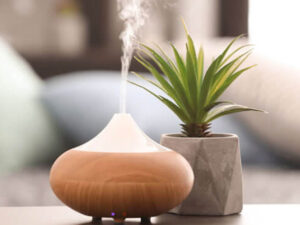This article was originally submitted as part of Andrea Canales’ final project for the Diploma in Aromatic Science at the Tisserand Institute.
Andrea Canales
In recent years we have seen a growing tendency to prefer natural products: plant-based food, plant medicine, natural cosmetics, etc. And within all this activity in the search for natural, essential oils have appeared on the scene since they come directly from plants and have various therapeutic properties. And if they are natural, we can use them without a problem because they are harmless, right? At least that’s the common belief.
 Essential oils have become very popular thanks to the exposure they have had on social networks and the arrival of various multi-level marketing (MLM) companies that sell them en masse. If we understand essential oils as powerful therapeutic tools, this ‘massification’ is good because it means that many more people will have access to, and know about them. However, the MLM movement also embraced some unsafe practices, including recommendations for essential oil ingestion. Every day we see TikToks or Instagram reels promoting their use to flavor food, drinking them in a glass of water as a detox routine, or even adding them to a shotglass as a way to glamorize ingestion. How safe is it to do this? Let’s first look at some background before we address that question.
Essential oils have become very popular thanks to the exposure they have had on social networks and the arrival of various multi-level marketing (MLM) companies that sell them en masse. If we understand essential oils as powerful therapeutic tools, this ‘massification’ is good because it means that many more people will have access to, and know about them. However, the MLM movement also embraced some unsafe practices, including recommendations for essential oil ingestion. Every day we see TikToks or Instagram reels promoting their use to flavor food, drinking them in a glass of water as a detox routine, or even adding them to a shotglass as a way to glamorize ingestion. How safe is it to do this? Let’s first look at some background before we address that question.
A little history
Aromatic plants have been used for thousands of years in the form of infusions, macerations, etc. for healing, and also in the kitchen. The Neanderthals are the first hominids that used herbs for their healing properties, presumably using trial-and-error to gain knowledge. Later, in ancient Egypt, we see the use of herbs and oils in religious rituals, in embalming, in perfumery and cosmetics, and also for therapeutic purposes. And let’s not forget Cleopatra’s beauty routines using herbs and macerated oils.
that used herbs for their healing properties, presumably using trial-and-error to gain knowledge. Later, in ancient Egypt, we see the use of herbs and oils in religious rituals, in embalming, in perfumery and cosmetics, and also for therapeutic purposes. And let’s not forget Cleopatra’s beauty routines using herbs and macerated oils.
The Arabs seem to be the inventors of distillation and creators of the alembic, and Ibn Sina or Avicenna (980-1037 AD) is said to have produced the first pure essential oil from Rosa damascena. Avicenna is known as “the prince of doctors”, he wrote more than a hundred medical texts, the most famous being the Canon of Medicine, in which he refers to several essential oils as treatments for diseases.
One of the earliest manuscripts that describing distillation as a method of obtaining essential oils was written by Arnald de Villanova (1235-1311) who details the distillation process of turpentine essential oil. In the 16th century, there were many writings about essential oils, especially about distillation since they couldn’t go to the store to buy them as we do. If you wanted an essential oil, you had to distill it yourself.
Paracelsus (1493-1541) was one of several physicians using distillation to separate essential oils from plants. He was the one who coined the famous phrase “All things are poison and nothing is without poison; only the dose makes a thing not a poison”, which means that a substance that contains toxic properties can cause harm only if it occurs in a high enough concentration. In other words, any chemical—even water—can be toxic if too much is ingested or absorbed into the body.
With the rise and development of pharmaceuticals, plant-based medicine declined in popularity as it began to be considered inferior or ‘unscientific’. This is why we had very little research Modern aromatherapy did not really begin until a French perfumer, René-Maurice Gattefossé (1881-1950), published his book Aromatherapie in 1937, the very first time that the word aromatherapy appears in print.
What are essential oils?
Essential oils are natural extractions from aromatic plants obtained by distillation of their leaves, flowers, bark, etc. In the case of citrus fruits, the essential oil is more often extracted by rasping of the peel, a process known as ‘expression’.
extracted by rasping of the peel, a process known as ‘expression’.
Essential oils are mostly lipophilic, meaning that they have an affinity for fats or lipids, such as fatty oils, skin lipids, and the membranes of our cells. They are also hydrophobic, that is, they repel water – they do not mix with it – just like when we try to mix a drop of cooking oil in water: it does not mix and floats on top of the water.
Also, they are very concentrated, because we need a lot of plant material to get just a little bit of essential oil. To give you an idea: the yield of essential oil from Peppermint leaves is about 0.5%, meaning that the essential oil, once extracted, is 200 times more concentrated than it was in the plant.
Essential oils are so concentrated that we must dilute them before putting them on our skin to reduce the risk of irritation or allergic reaction. So, if we ingest that one little drop, just imagine what will eventually happen with your gastric mucosa, which is even more sensitive to irritation than skin. It can become irritated, even though we might not be able to feel anything.
Last but not least: Essential oils are made up of small molecules that give them their therapeutic properties. These are mostly terpenes such as limonene, α-pinene, and β-caryophyllene, but also oxides, aldehydes, esters, ketones and others. Some essential oils contain only a few different molecules – like Wintergreen (Gaultheria procumbens), which consists of 99% methyl salicylate. But most essential oils contain hundreds of constituents so we can say that they are chemically complex. Although minor constituents often show only weak activity, or none at all, they can have a significant role in interactions between constituents which can also affect the overall biological activity. A few are highly active even in small concentrations (Ratajc 2022).
How should we use essential oils?
 The most commonly-used routes of administration are topical, inhalation, and oral. In some countries, essential oils are also used vaginally and rectally.
The most commonly-used routes of administration are topical, inhalation, and oral. In some countries, essential oils are also used vaginally and rectally.
Topically, we apply previously diluted essential oils to our skin, either through a massage, a body lotion, an ointment, a rollerball, etc. There are recommended dilutions according to the age of the person, pregnancy, the part of the body where they are going to be applied, and the use that you are going to give to your aromatic preparation (cosmetic, muscular pain, etc.). Further, some essential oils have specific dilutions recommended according to their safety issues. The excipient (carrier) of the essential oil will often contribute to the therapeutic objective, also to increase or reduce absorption, etc., so it is important to choose it well.
For inhalation, we usually use an aromatherapy diffuser, a bowl of hot water, a tissue, a cotton pad, or a personal inhaler. Through this route, essential oil constituent molecules reach the limbic system in just a few minutes, which is why it is a widely used route in aromapsychology. Inhalation is also used for various respiratory problems. A few essential oils cannot be used by inhalation due to their toxicity, and others have restrictions and contraindications for some people who may possess a personal risk factor, such as asthma, epilepsy, or being a toddler.
 In the oral route, we ingest the essential oil previously diluted in a suitable excipient. This preparation is carried out by a person who has training in aromatherapy for oral use, using capsules that will be prescribed for a specific therapeutic objective, with a given frequency, and for a limited number of days. Oral doses are calculated either by age or by body weight and they are given in mg or mg/kg. Some essential oils cannot be ingested due to their toxicity, and others have restrictions and contraindications (Tisserand 2022).
In the oral route, we ingest the essential oil previously diluted in a suitable excipient. This preparation is carried out by a person who has training in aromatherapy for oral use, using capsules that will be prescribed for a specific therapeutic objective, with a given frequency, and for a limited number of days. Oral doses are calculated either by age or by body weight and they are given in mg or mg/kg. Some essential oils cannot be ingested due to their toxicity, and others have restrictions and contraindications (Tisserand 2022).
What happens when essential oils enter our body?
Although we usually consider essential oils as natural, our body treats them as foreign substances. This is because essential oils don’t contain nutrients – they don’t provide building material such as protein, nor are they a source of energy. Once in the body, essential oil constituents are not recognized as a normal part of the system or beneficial to the organism but rather as foreign substances – xenobiotics – which must be broken down and removed as soon as possible (Ratajc 2022).
 The liver is the main organ responsible for the inactivation and removal of xenobiotics. Liver cells – hepatocytes – contain a variety of enzymes capable of the biotransformation of many different substances, including essential oil constituents. This means that one type of molecule is transformed into a different type, such as limonene into perillyl alcohol. One important reason for this is that essential oil constituents are made more water-soluble so they can be excreted in the urine. The metabolism of essential oil constituents is generally efficient and rapid (Ratajc 2022).
The liver is the main organ responsible for the inactivation and removal of xenobiotics. Liver cells – hepatocytes – contain a variety of enzymes capable of the biotransformation of many different substances, including essential oil constituents. This means that one type of molecule is transformed into a different type, such as limonene into perillyl alcohol. One important reason for this is that essential oil constituents are made more water-soluble so they can be excreted in the urine. The metabolism of essential oil constituents is generally efficient and rapid (Ratajc 2022).
When we ingest an essential oil, the bioavailability (or the fraction of its molecules that reaches the systemic circulation unchanged) is close to 95%. This is in contrast to topical absorption (5%) and inhalation (50%) (Ratajc 2022). That is: this route of administration is the one with the highest concentration of molecules entering our body. Compared to inhalation or topical application, ingesting essential oils results in a quite sudden surge of constituents in the blood supply to the liver. There is a risk that this could overwhelm the capacity of detoxifying liver enzymes, and may result in liver toxicity. Whether or not this actually happens depends on the dose, how frequently it is taken, the essential oil(s) in question, and the health status of the individual (Tisserand 2022).
What happens with these molecules when entering our body and the effects the body has on them is known as Pharmacokinetics, and it involves these four processes: Absorption (transfer of constituents from the site of administration to the bloodstream), Distribution (transfer of constituents from the site of absorption through the body), Metabolism (a series of enzyme-mediated chemical reactions in which substances are often transformed into more water-soluble and less toxic molecules) and Excretion (removal of constituents from the body, mainly with urine, but also possible with feces, through skin, milk or sweat). The Pharmacokinetics of essential oil constituents is different depending on the route of administration of the essential oil (Ratajc 2022).
In the inhalation route, the constituents of the essential oil reach the lungs, and through the alveoli they enter the bloodstream, where they are distributed throughout the body and finally reach the liver to be metabolized. In the topical route, they enter through the skin, reaching the systemic circulation where constituents will be distributed around the body to later reach the liver to be metabolized.
Through the oral route Essential oil constituents may be absorbed from several sites along the gastrointestinal tract (the oral cavity, esophagus, stomach, and small intestine) directly into the hepatic portal vein which drains into the liver. Molecules are thus metabolized to some extent in the so-called first-pass metabolism before they reach the systemic circulation, travel through the body, and reach the liver again for more biotransformation and excretion (Ratajc 2022). That is: by the oral route, not only does our liver receive a higher concentration of essential oil molecules as we said before, but also, we give it twice the work since it is the only route of administration with the first hepatic pass.
To make it even more complex, when we ingest an essential oil, one of its molecules may have an interaction with a medication that you are taking and this can result in the drug having either an enhanced effect (even leading to an overdose) or else a diminished effect (so it may not do what it’s supposed to do). Potential interactions exist with many drugs in popular use, including aspirin. Since ingestion results in high bioavailability (amount in blood) of essential oil constituents, the risk of interaction is greater than for inhalation or topical application (Tisserand 2022).
Knowing all of the above, is it safe to ingest essential oils?
While essential oils are naturally derived, they have been artificially concentrated and are therefore more potent than the originating plant (Tisserand 2022). When we ingest an essential oil, we are ingesting a very concentrated and chemically complex substance, which will be absorbed into our systemic circulation and that could have an interaction with a medication we are taking. This sounds dangerous and it is, if you don’t know what you’re doing.
A couple of days ago I read Robert Tisserand comparing ingesting essential oils to crossing a street (Tisserand 2018). Is it safe to cross the street? It is undoubtedly dangerous to do so, and the number of people and animals that get run over confirms this. But if we know how to do it and know the issues we need to be aware of and the factors at play, we can cross the road safely without risking our health.
So my answer is yes, it is safe to ingest essential oils, AS LONG AS you follow the recommendations of an aromatherapist who is trained in oral use, who will know very well what ESSENTIAL OIL you need for the therapeutic objective, in what DOSE, for how many DAYS, with what FREQUENCY of use and with which EXCIPIENT; and will monitor your treatment to see that everything is going correctly.
But if you are going to use essential oils orally following the recommendations you saw on social networks, with a 99% probability I assure you that those recommendations will not be correct. If you don’t believe me, let’s take a look at a few:
- Add one or two drops of essential oil in a glass of water and then drink it: essential oils do not mix with water! This is the same as ingesting them undiluted, with a high risk of irritation or burning of your digestive mucosa, gastric ulcers, etc.
- Take essential oils every morning as a self-care routine: Essential oils taken orally have the highest bioavailability and should only be used for a short time to reduce the risk of internal toxicity and liver overload.
- Adding essential oils to a shotglass because you think it’s cool: you will only be giving your liver even more work!
Essential oils are wonderful therapeutic tools for our physical and mental well-being, but they are not devoid of risk. Possible adverse effects of oral use include irritation of mucus membranes, hepatotoxicity, nephrotoxicity, teratogenicity and neurotoxicity. Toxicity can be acute (from a single dose) or chronic (from long-term exposure). You may have followed one of those social media recommendations and nothing bad happened to you, but the problem with internal damage, as opposed to skin irritation and allergy, is we may not see it happening until it’s too late. Liver toxicity, fetotoxicity, drug interactions and carcinogenicity for example, are not usually obvious at the time that the damage is being done (Tisserand 2022). So please always remember – just because a substance is natural doesn’t mean it’s harmless. Know your essential oils, use them correctly, seek the advice of a competent aromatherapist to minimize risks, and enjoy safe and effective aromatherapy!
References
Bowles, J. (2022) Aromatic Chemistry https://tisserandinstitute.org/aromatic-chemistry/
Cordero, C. (2022). Diplomado Internacional en Aromaterapia Científica, clase ¿Qué es la aromaterapia? . https://heavenbiotech.cl/producto/diplomado-en-aromaterapia-cientifica/
Ratajc, P. (2022). Essential Oil Kinetics Masterclass: From Application to Effect. https://tisserandinstitute.org/essential-oil-kinetics-masterclass/
Tisserand, R. (2018, April 2). Post on Tisserand Institute Facebook Page. https://www.facebook.com/RobertTisserandEssentialTraining/posts/to-ingest-or-not-to-ingest-that-indeed-is-the-question-in-aromatherapy-and-the-a/1836796429684883/
Tisserand, R. (2022) Essential Oil Safety Masterclass 2nd Edition https://tisserandinstitute.org/essential-oil-safety-master-class/
Vergara, MP. (2023). Diplomado en Aromaterapia Integrativa, clase 2 historia de la Aromaterapia . https://aromarmonia.com/cursos/diplomado-de-aromaterapia-integrativa-2023/
Image credits:
https://www.fenghi.es/pages/vias-aplicacion-aceites-esenciales
http://antiguosaber.blogspot.com/2013/12/la-alquimia-el-arte-de-la-transmutacion.html
https://pharmaspa.ca/what-is-aromatherapy/
https://www.amazon.com/-/es/Rene-Maurice-Gattefosse-ebook/dp/B007BLO7HS
https://www.bienverde.cl/cual-es-la-mejor-marca-de-aceites-esenciales-en-chile/
https://m.facebook.com/story.php?story_fbid=876153635877081&substory_index=0&id=851362001689578
https://humidificadores.mx/noticias/conozcan-el-funcionamiento-de-los-nebulizadores-ultrasonicos/
https://www.mdpi.com/2039-4713/11/4/9
https://tisserandinstitute.org/
https://www.toolboxgenomics.com/blog/what-is-pharmacogenetics-an-overview/
https://www.instagram.com/p/CtgpsLzOk1d/
https://www.instagram.com/p/CYoSbA6L4ht/
https://annie.hansennet.dk/4-refreshing-mocktails-to-sip-on-this-summer/

Andrea Canales
Author
Andrea is Chilean, she lives in Santiago with her husband and 4 children. She discovered aromatherapy 9 years ago thanks to her son Simón. In 2016 she joined a multi-level aromatherapy company to share what she was using with others. There, she began to open her eyes to the world of essential oils and their therapeutic properties as well as their risks, and she wanted to know more about them. She decided to train as an aromatherapist, and at the same time expand her knowledge even further, taking almost all the courses offered by the Tisserand Institute, including Diploma in Aromatic Sciences and Diploma in AromaDermatology. Currently, she continues studying, teaching what she has learned and creating personalized formulations for her family and for those who need it, and plans to open an integrative aromatherapy practice in the near future.




0 Comments